How to get dressed like an Ancient Greek woman
It's more than just slapping on a glorified bedsheet and some strappy sandals and calling it a day
Welcome to this week’s edition of Reading Art!
In the Homeric Hymn to Aphrodite, which dates to around the 7th century BCE, the poet describes a striking story about Aphrodite, the goddess of love, sex and beauty: the time she was compelled to fall in love with Anchises, a mortal. This was a punishment orchestrated by Zeus for causing him and many of the other gods to also fall in love with humans and resultantly do things they would really prefer not to do, such as commit adultery, parent half-god children, and generally make fools of themselves. In mythological terms, this is important because it explains how the famous Trojan hero Aeneas was born as a result of this love affair. However, my favorite part of the whole thing is the iconic getting-ready scene that ensues when Aphrodite is preparing to seduce Anchises.
The hymn describes the careful care that Aphrodite took when getting ready; being a beautiful goddess was apparently not enough to ensure that Anchises would be interested in her (translated by G. Nagy, with modification):
When Aphrodite, lover of smiles, saw him,
she fell in love with him. A terrible desire seized her in her phrenes.
She went to Cyprus, entering her temple fragrant with incense,
to Paphos. That is where her sacred precinct is, and her altar, fragrant with incense.
She went in and closed the shining doors.
Then the Graces bathed her and anointed her with oil
—the kind that gives immortality, glistening on the complexion of the gods, who live forever and ever.
Immortal it was, giver of pleasures, and it had the fragrance of incense.
Then she wrapped all her beautiful clothes around her skin.
She was decked out in gold, Aphrodite, lover of smiles.
…
When Anchises saw her he was filled with wonder as he took note
of her appearance and stature and splendid clothes.
For she wore a robe that was more resplendent than the brightness of fire.
She had twisted brooches, and shiny earrings in the shape of flowers.
Around her tender throat were the most beautiful necklaces.
Her dress was a thing of beauty, golden, decorated with every sort of design.
Like the moon it glowed all around her tender breasts, a marvel to behold.
When you think of fashion in the ancient world, the first thing that comes to mind is probably the toga, one of the big iconic emblems of life in the ancient Mediterranean. It’s true that both men and woman wore basically wore drapy, toga-like clothes, but—just like today—women put a lot of thought into how they expressed themselves through their clothing, accessories, and even their hair. In today’s virtual gallery tour, we’ll explore how both human and divine women used fashion to express themselves and their unique identities.
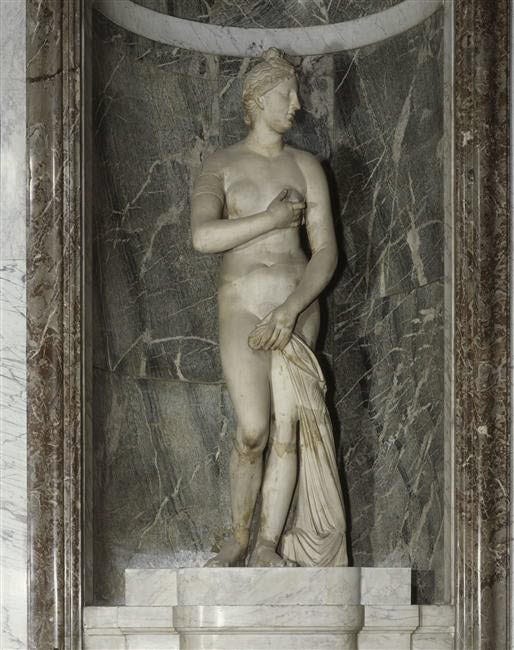
In general, in the art historical record the goddess of love wears, well, nothing, or next to nothing, emphasizing her divine sensuality. But, as the Hymn to Aphrodite shows, clothes were still important, even for goddesses: her radiant dress, golden jewelry, and heavenly perfume are selected with particular care. The clothes are an extension of the person who chooses to wear them; or, thought of another way, even the immortal body has a certain essential blankness to it, like a canvas, that begs to be adorned.
What always strikes me about ancient art is how mortals and gods are often dressed in rather similar clothing styles, which is possibly a material point of connection between humanity and the divine. For example, see this statuette of a woman wearing the traditional garment for women in the Classical period, the peplos:
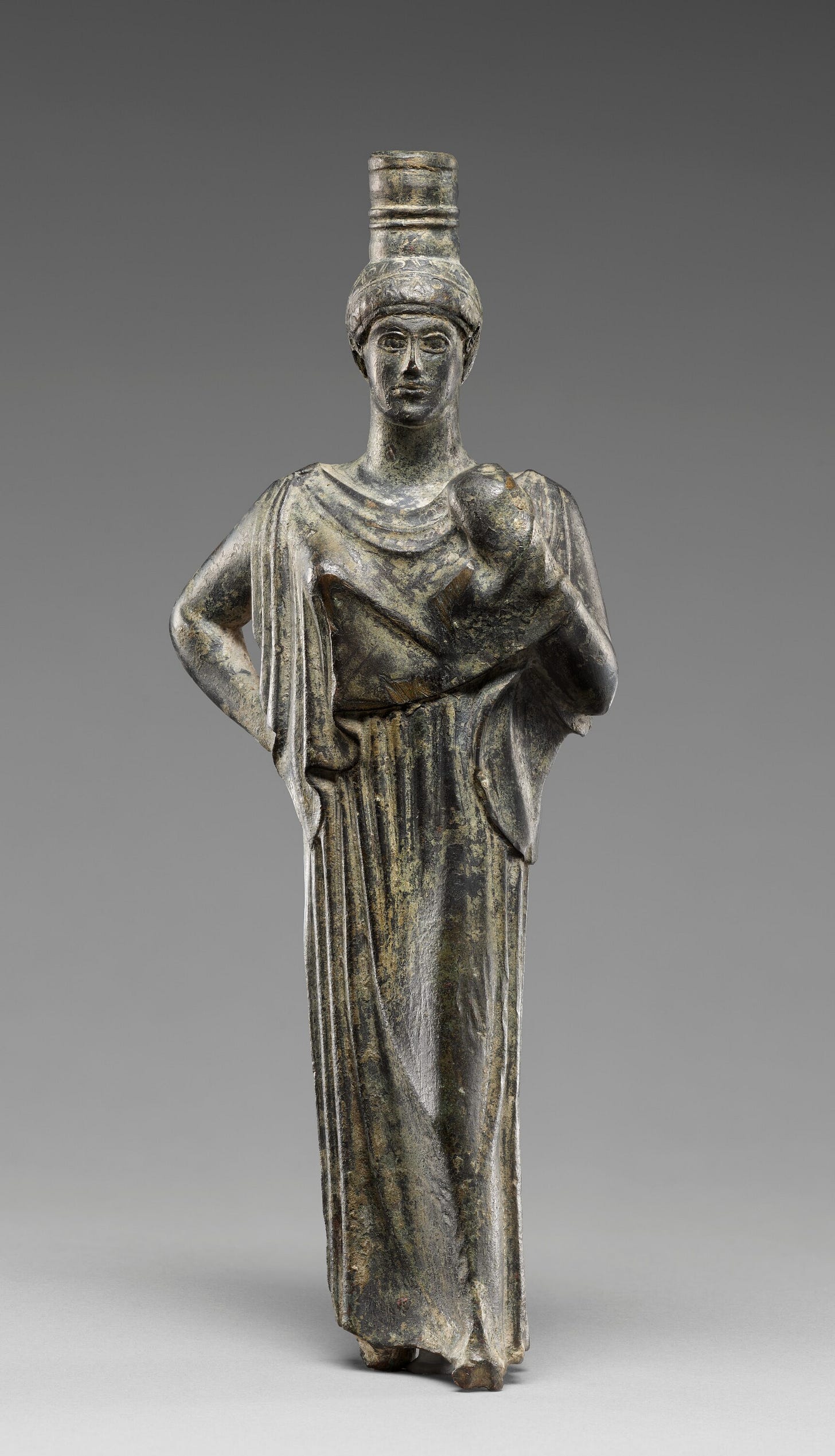
This was a flowy garment that fastened at the shoulder with a pin or brooch and hung down in loose folds to the ankles. Women tended to wear their hair up, and sometimes wore headpieces, as we can see on the figure above.
The peplos had ritual significance as well. Every year in Athens, for example, one of Athena’s priestesses, assisted by a group of girls, would weave a peplos depicting the mythological battle between the gods and the Giants. Most importantly, the garment would illustrate Athena’s famous triumph over the giant Enceladus. The finished peplos would then be carried up in a procession to one of Athena’s statues and presented to the goddess as an offering.
Here’s another example from a similar time period. In addition to the peplos, the woman depicted here is wearing a mantle, which is like a shawl or cape, and could be made of wool or possibly linen. Her hair is gathered up on her head and contained by a headband.
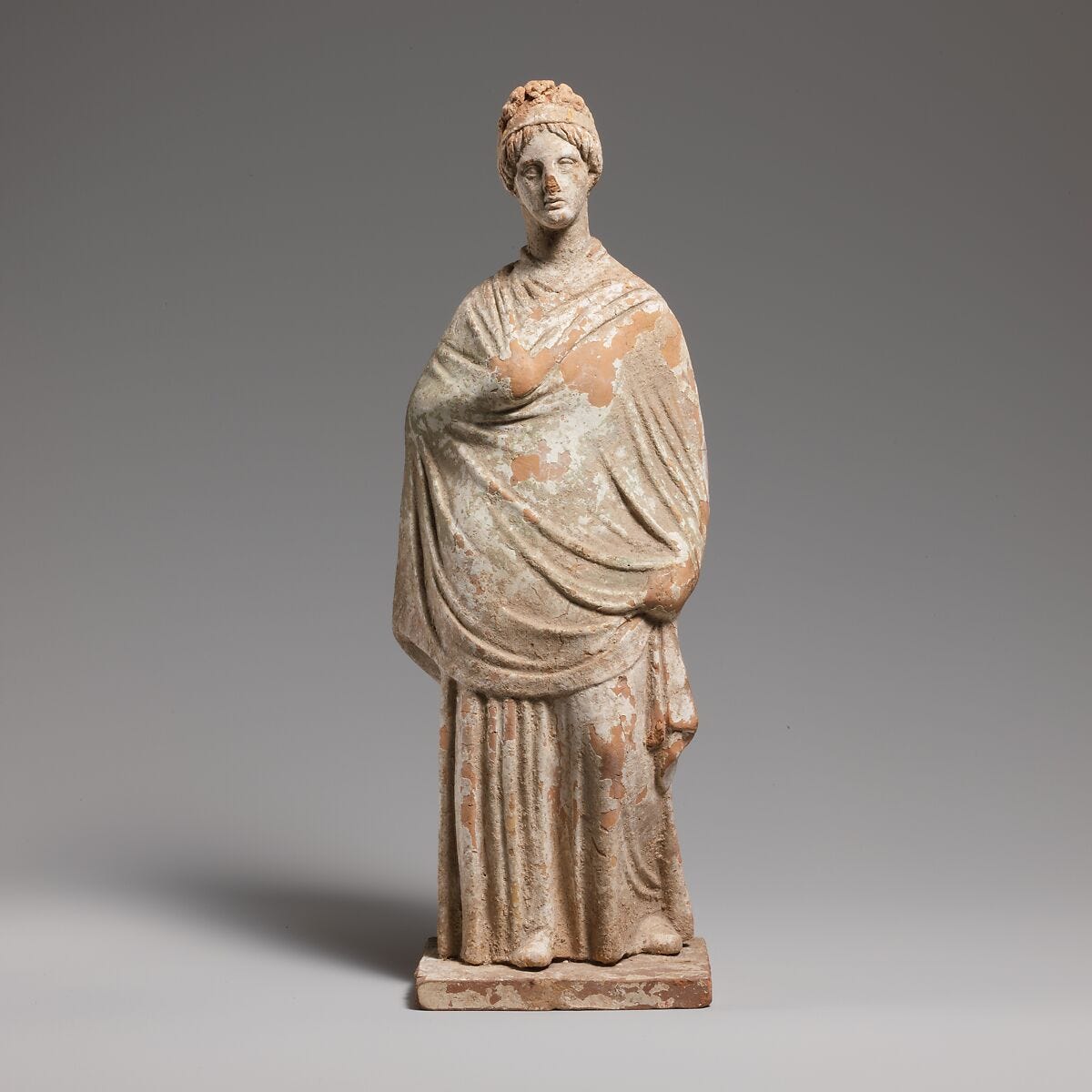
Ancient texts occasionally mention women wearing veils, though it is a point of scholarly debate as to how often and when veils were worn, and by whom. This was true of both the Greeks and the Romans, whose garments were somewhat similar to those of the Greeks. See, for example, this Roman statue from approximately the reign of Marcus Aurelius:
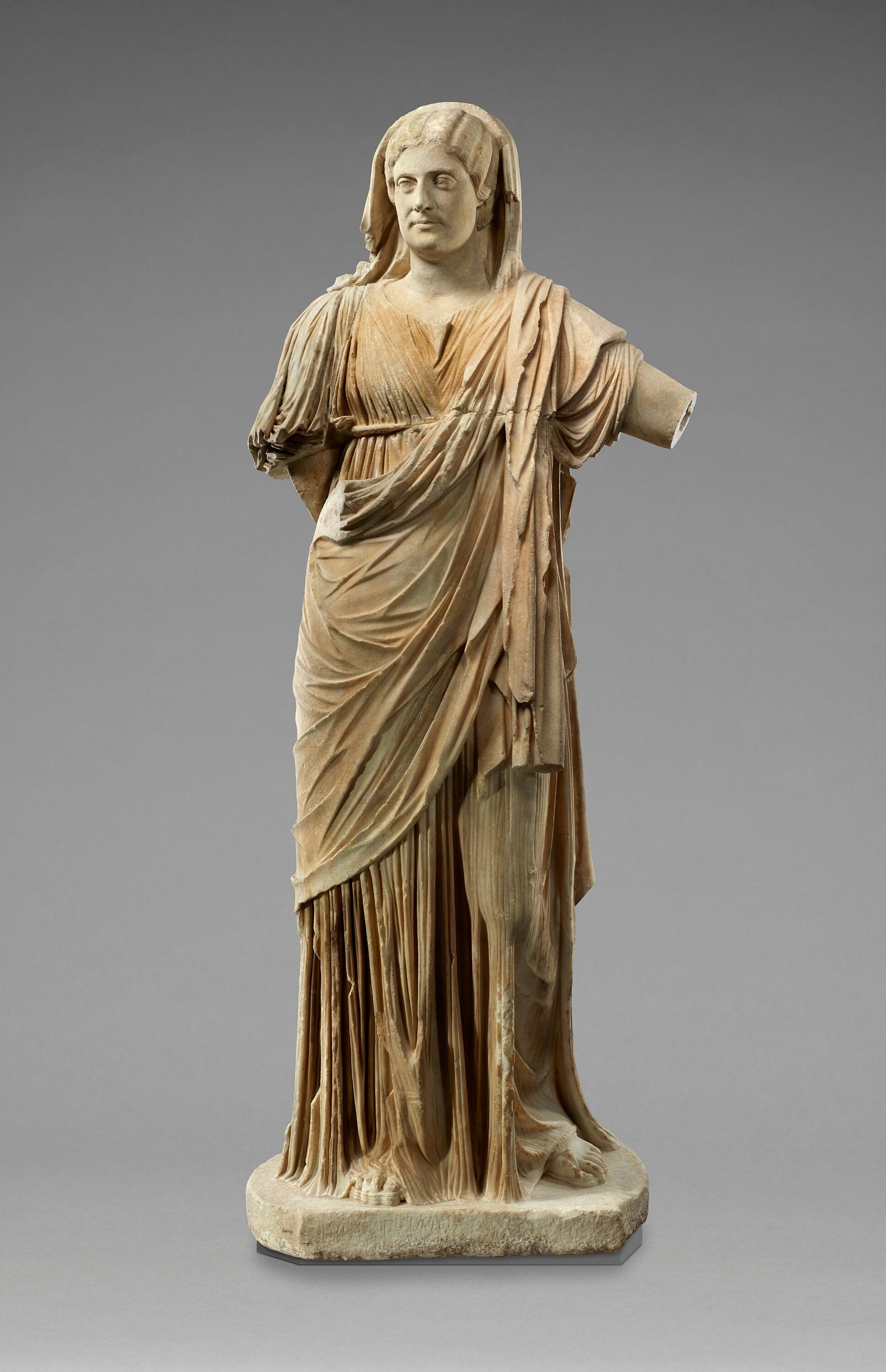
Some have speculated that high-status women wore them whenever they left the house, though women of the middle and lower classes may have worn them as well. This may have been a mark of status as a modest matron; there is not much mention of girls wearing them. Certainly, brides were often veiled, for similar symbolic reasons as in more recent times. I will say that there is scant evidence for women always wearing veils when they left the house, and the wearing of veils does not appear to have been encoded in religious or civic law. It seems to me that it was more of a personal choice and not a default societal expectation, especially since women are frequently depicted not wearing veils.
In fact, depending on the era, a veil might have been quite impractical to wear. Take a look at this Roman woman from the Flavian era (mid-first century CE):
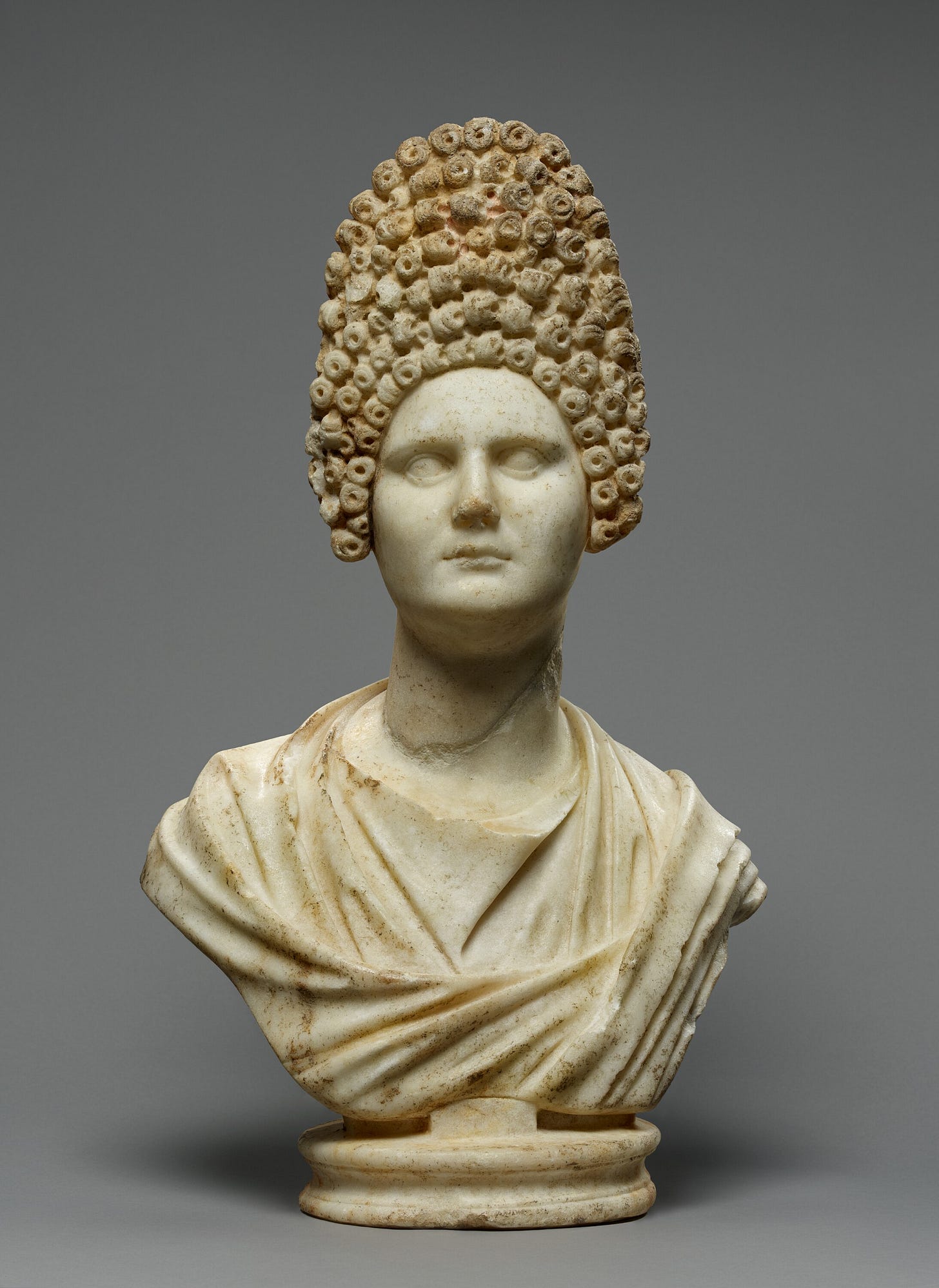
The towering rows of tight curls look more like one of Marie Antoinette’s wigs, but it was the height of fashion for aristocratic women—who, I want to note, had the help of enslaved maids to assist them in getting ready every day.
In this regard, impractical and elaborate fashions were a mark of status because, in the Greco-Roman view, the elite person did not do manual labor of any kind, including getting dressed alone.
But what about non-elite women? Unfortunately, there’s not as much evidence describing their apparel, but it seems to be the case that they wore similar styles to aristocratic women, but in simpler cuts and with less jewelry and perfume, and definitely without a fussy hairstyle that required multiple women and heating up a pair of iron tongs to make curls (yes, they had curling irons!).
Women also used fashion to communicate and embody their devotion to a certain deity. For example, here’s one of my favorite ancient statues of all time, which depicts an older woman carrying a basket:
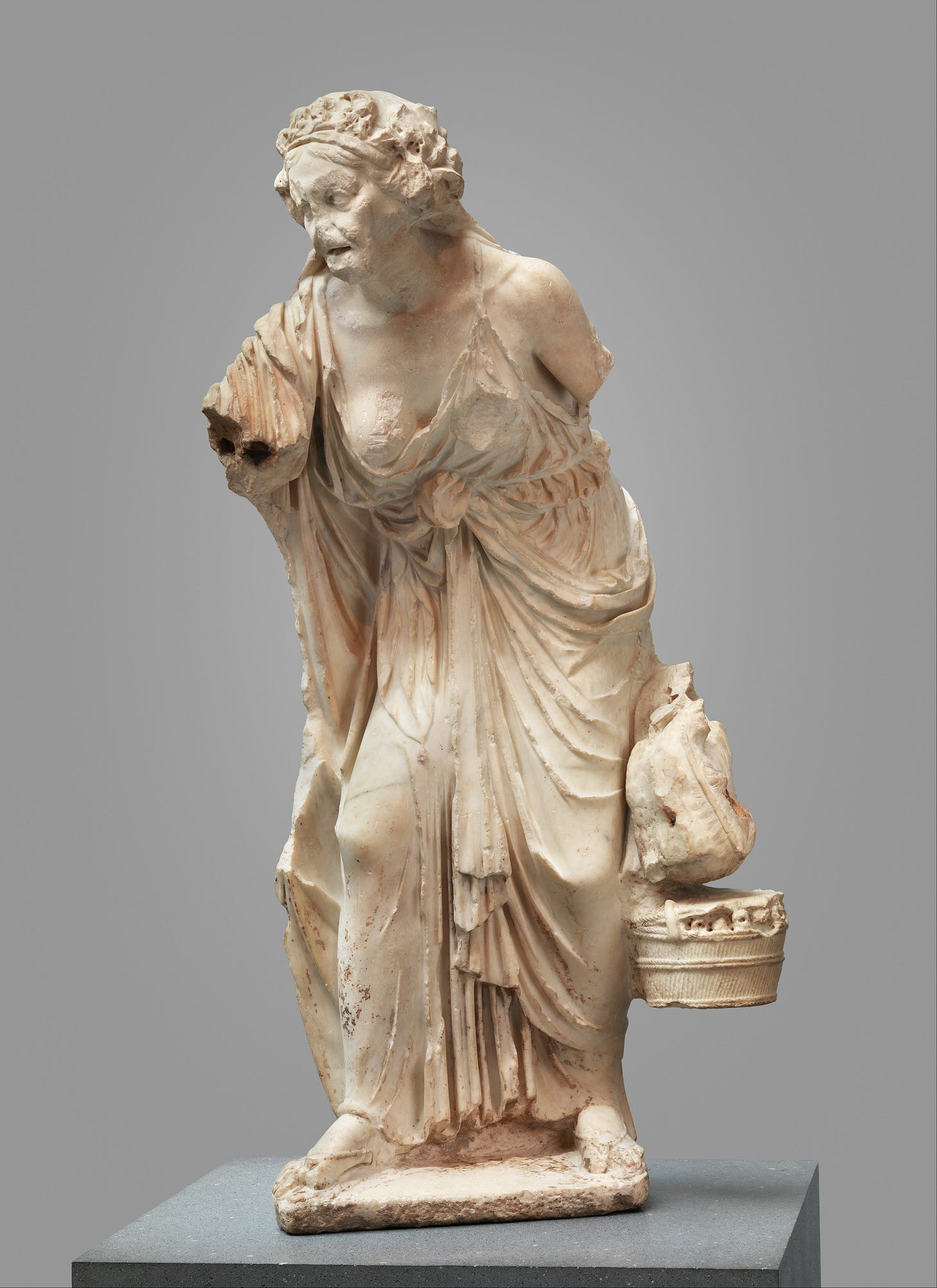
If you look carefully, you see that she has a wreath of ivy on her head, which marks her as a worshipper of Dionysus, the god of wine, theater, and madness (a combination to discuss another time!). Scholars speculate that she is an aged courtesan on her way to a festival in honor of the god, an impression bolstered by the fact that her garment is falling forward to reveal some of her breast. But what I find fascinating is that, despite her advanced age and arthritic posture, her finely-draped clothing resembles that of a goddess in many respects. Her ivy headband and fine clothes give visual proof of her closeness to the divine.
Sometimes, the wealthy would commission statues of themselves with divine attributes. As an example, let’s take a look at this statue of an older Roman matrona in the guise of the goddess Cybele:
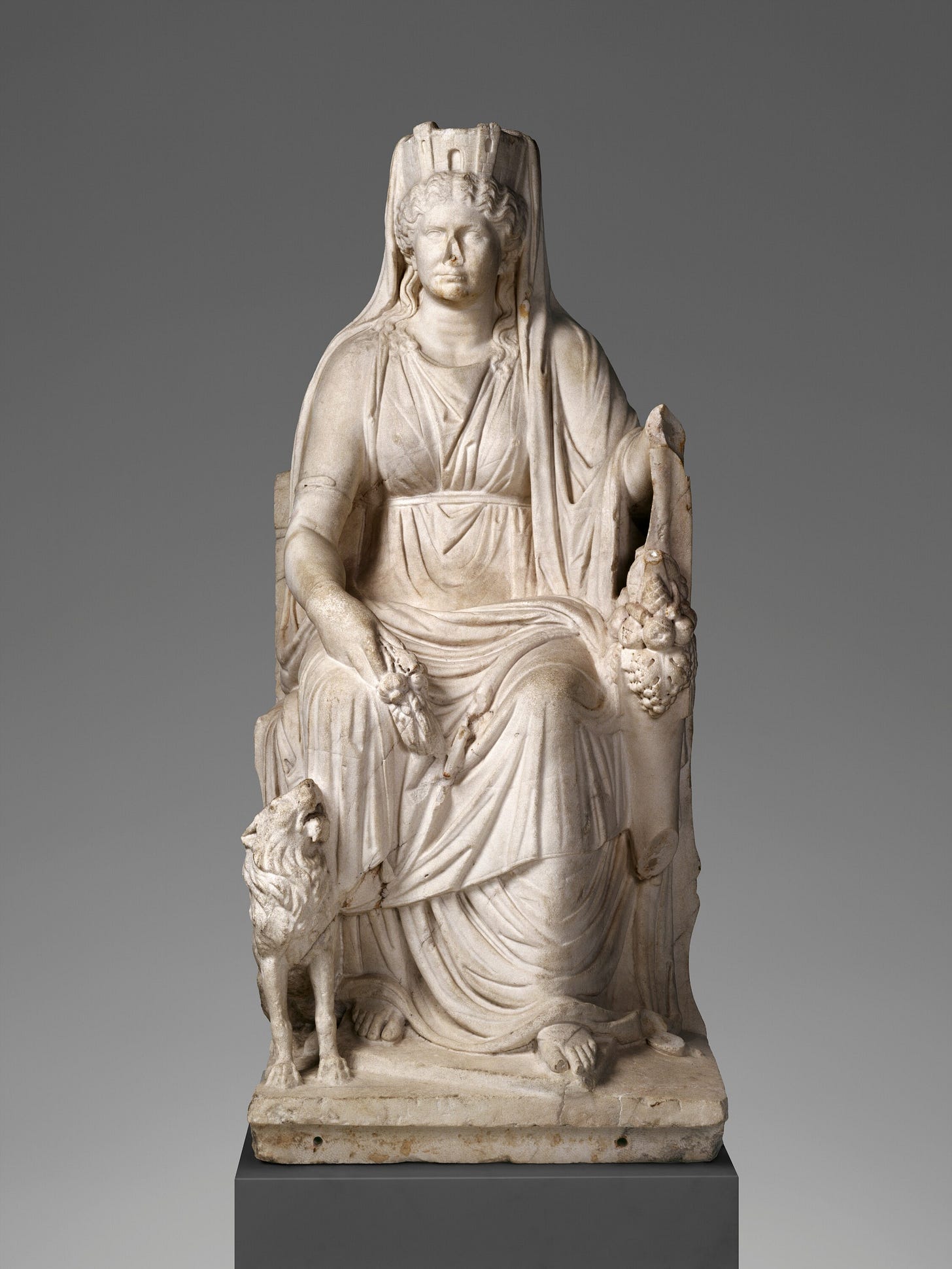
Cybele was a goddess from the eastern part of the Mediterranean world, and was often referred to as the Great Mother Goddess. She was a goddess of the wild in many ways, not unlike Artemis, only she was even more strongly associated with motherhood and fertility. Often accompanied by panthers and lions, she was also known to wear a crown that was shaped like the walls of a great city, as we can see here.
But the woman isn’t exactly Cybele, or at least she is not portrayed as a goddess normally would be, with a youthful or at least kind of ageless face. Instead, we see that this Cybele is clearly in middle age, suggesting that it was probably meant as a portrait of an aristocratic woman, maybe one who was known as a civic benefactor or patron. Or, as some have suggested, the portrait could portray one of Cybele’s priestesses, since Cybele was kind of an unusual choice of goddess—because she hailed from Anatolia (modern-day Turkey), she wasn’t as popular as, say, Athena or Hera. But I think that the city-wall crown is the most striking part of the statue, as it draws our eye up to the face of the women whom the statue depicts, and leaves the viewer with a strong impression of this woman as a “mother to the city.”
Once again, we see how clothing and accessories function not only to communicate wealth and status, but also to proclaim a woman’s connection to divinity. If we think back to the Homeric Hymn to Aphrodite, it was her apparel that was partly responsible for making her so seductive to human eyes. (Side note: lest you think she went to all that effort just because Anchises was a human, note also that in the Iliad the queen goddess Hera goes to a similar effort when trying to seduce her husband, Zeus, for political reasons). Clothing as a mortal/immortal point of connection therefore seems to go both ways.
Recall also that Aphrodite put a lot of effort into her personal grooming regimen, using perfumed oils as part of her beautification routine. Human women did something similar too, using homemade remedies and cosmetics to enhance their appearance. We actually have texts that give us some insight into the process: the love poet Ovid wrote the Medicamina Faciei Femineae (Cosmetics for the Female Face) in the early first century BCE. As the title suggests, the poem describes various facial treatments, which include some familiar ingredients such as oatmeal for improving the complexion. Still, Ovid takes care to make the timeless point that beauty is less about one’s outward look and more about how one behaves.
Thank you for reading this week’s newsletter!
As it turns out, ancient Greek and Roman women—and goddesses—had as much fun with fashion and trends as we do today. Although their flowing, toga-like clothes look kind of the same from the archaic Greek period all the way to the Imperial Roman era, we saw today that there were definitely nuances and shifts in the ways in which women used fashion to express themselves. As ever, clothes remain a way to simultaneously declare individuality and belonging within the sociocultural group.
I hope you enjoyed this one! I would love to hear from you in the comments. Take care until next time.
MKA
QUESTIONS FOR FURTHER REFLECTION
To what extent is it the case that humans are portrayed like gods with regard to their clothing and hairstyles? Or are the gods simply portrayed in human terms?
While the Greeks and Romans thought of the idealized face as youthful, they don’t shy away from depicting older people in their works of art. How are older women portrayed as opposed to younger women?
In the ancient world, statues were actually painted with fairly bright colors. How would a colorful version of these statues change your interpretation of them?



